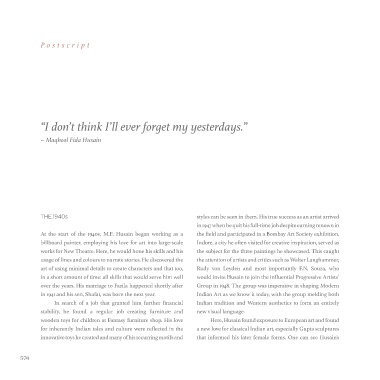Page 578 - M F Husain The Eternal Master
P. 578
P os ts cript
“I don’t think I’ll ever forget my yesterdays.”
~ Maqbool Fida Husain
A picture of Husain observing one of his paintings
affinity for depicting the rural population, wanting to share Here, he was introduced to Chinese calligraphy, the energetic
his love for India during one of the country’s most tumultuous brushstrokes of which he would revisit often throughout his
THE 1940s styles can be seen in them. His true success as an artist arrived phases. With these works, he explored the beauty of India’s career. He was also taken by the horse paintings of Xu Beihong
in 1947 when he quit his full-time job despite earning renown in cultural diversity despite conflict. and horse sculptures of the Song Dynasty, resulting in the
At the start of the 1940s, M.F. Husain began working as a the field and participated in a Bombay Art Society exhibition. His need to create a distinct visual syntax can also be seen horse becoming a motif that recurred in his works throughout
billboard painter, employing his love for art into large-scale Indore, a city he often visited for creative inspiration, served as in the many techniques he experimented with, veering towards his career.
works for New Theatre. Here, he would hone his skills and his the subject for the three paintings he showcased. This caught the expressionist style. Despite being deeply influenced by Many of his early works were also influenced by Amrita
usage of lines and colours to narrate stories. He discovered the the attention of artists and critics such as Walter Langhammer, Basholi miniatures among other traditional Indian art, he was Sher-Gil and were a melancholic portrayal of rural folk. He
art of using minimal details to create characters and that too, Rudy von Leyden and most importantly F.N. Souza, who keen to create a new iteration of art entirely his own that did continued to experiment with his mediums, techniques and
in a short amount of time: all skills that would serve him well would invite Husain to join the influential Progressive Artists’ not mimic those of yore. forms during this decade, creating varied stylised portrayals of
over the years. His marriage to Fazila happened shortly after Group in 1948. The group was imperative in shaping Modern the same subjects, especially female forms.
in 1941 and his son, Shafat, was born the next year. Indian Art as we know it today, with the group melding both THE 1950s In the mid-1950s, he became interested in depicting the
In search of a job that granted him further financial Indian tradition and Western aesthetics to form an entirely inner turmoil of man and the human condition using symbols
stability, he found a regular job creating furniture and new visual language. The early 1950s saw the introduction of various influences into and motifs that could be seen in rural settings. By this time, he
wooden toys for children at Fantasy furniture shop. His love Here, Husain found exposure to European art and found Husain’s works. In 1952, Husain, along with intellectuals such had become more assured of his self expression, using tools
for inherently Indian tales and culture were reflected in the a new love for classical Indian art, especially Gupta sculptures as Ismat Chugtai, Krishen Chander and Mulk Raj Anand, that could be seen in many later works. His penchant for flat
innovative toys he created and many of his recurring motifs and that informed his later female forms. One can see Husain’s travelled to Beijing for the Asian Pacific Region Peace Congress. colour planes, bold linework, motifs and rustic scenes and
576 577

